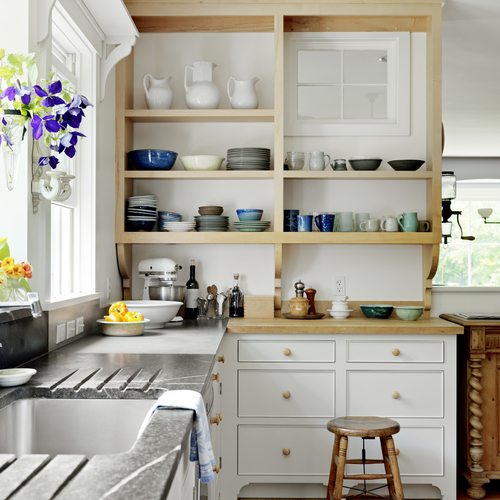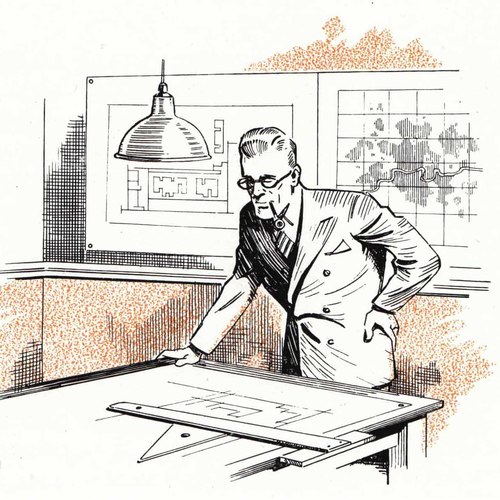
Image Credit: Image #1: Athene Rafie
Why are most interior doorways only 30 inches wide? Why are so many doorknobs hard to grip? And why do so many homes have a long stairway between the front door and the bedrooms?
Two typical answers to these questions would be, “because that’s the way we’ve always built houses” and “because these houses meet code.” (Those two reasons happen to be pretty weak, by the way.)
We’re all getting older, and many of us have family members with special needs. Ideally, the homes we build today will work well for people with a wide range of abilities. Designing buildings that can meet the needs of people with varying abilities is called “universal design.”
Most families have members with special needs; for example, my sister-in-law Caryn is blind. Caryn’s not a complainer, but I’ve learned a lot from Caryn about sidewalks. Some sidewalks are easy for blind pedestrians with canes to navigate; others are unsafe. Ideally, sidewalk surfaces should be consistent and predictable, with as few bumps and hard-to-interpret transitions as possible.
People come in all shapes and sizes
Universal design strives to make buildings easy for a wide variety of people to use, including older people and people with disabilities. As much as possible, universal design attempts to meet the needs of people of all ages, sizes, and abilities.
A house that follow universal design principles often aims for “visitability” — including ease of use by friends in wheelchairs — and aims to accommodate owners planning an “aging in place” retirement. A house built to universal design principles should make it easy for the owners to live independently in their home for as long as possible.
Features that fall into the “universal design” category should be usable by a wide variety of people of different sizes and…
Weekly Newsletter
Get building science and energy efficiency advice, plus special offers, in your inbox.

This article is only available to GBA Prime Members
Sign up for a free trial and get instant access to this article as well as GBA’s complete library of premium articles and construction details.
Start Free TrialAlready a member? Log in















25 Comments
Good design is Green design
This is excellent and I could go on and on with adding to your list. This is also a good selling point for hiring a good architect. I watched my father for a decade after his stroke as he navigated his life with a walker, wheelchair and cane and learned many lessons that are not in the standard ADA manuals for accessible design. Accessible design and planning is part of making a home green in that it adds to the equation that makes a home useful for a wider range of occupants over a longer span of years. As an architect, I need to be designing for much more than the current client and their current needs and even for their projected needs. Who will be using the house in 50 or 100 years? If a house outlives it's usefulness in a few decades, how green is that? As a side note, I am fascinated with the tiny house movement and I'm all for it but, at age 46, those loft beds are looking rather impossible as are the under counter fridges. The good thing is that a well built tiny house can so easily transfer to new occupants as needs change.
One solution to your kneading problem...
Thanks for a good article that reminds us to integrate universal design, not segregate it.
Not to be flippant, but here's a really good no-knead bread recipe that makes for a wonderful, crusty boule:
http://www.nytimes.com/2006/11/08/dining/081mrex.html?_r=0
oven door height
The typical built in oven, either under the counter or part of a range, is too low. Hauling out a big pan is tough on the back. Wall ovens, on the other hand, tend to be too high and taking out a hot pan is often dangerous.
In our new kitchen, I'll be building an oven cabinet which places the oven at the right height. I'll use the space under it for a drawer to accommodate pots and lids.
Why does anyone use door knobs?
I've been baking organic sourdough bread for a living for the last 37 years and I agree with you about the oven height. Another issue is the way the oven door opens. If you don't want to keep the door open too long when checking on your cooking you are likely to parboil your eyes or lose your glasses into the oven where they will melt. There are small commercial ovens with double doors hinged on the side which open one handed. Enjoy your baking.
A few comments
Martin,
Very timely topic. Another approach, which has larger architectural implications, is to provide a variety of dwelling units on one site. I worked on a project thirty years ago where I took the standard urban lot in Vancouver and designed a house with a basement suite and a lane way unit over the rear garage. The owners would have been able to choose which to live in and which to rent out. The renters could also be family or caregivers to support the owners as they aged. Providing continuity and allowing people to stay in their homes, goes a long way to solving many of the problems they face as they age.
John,
To simplify Lahey's recipe even further: don't bother to move the dough from the bowl after the first rising. Just knock it down and let it go another couple of hours. Much less mess, results are the same.
Stephan,
The city of Vancouver just outlawed door knobs in their new building code.
Light Switches and Door knobs
Martin wrote: "Tall people may prefer higher light switches"
as a "tall person"... I have no problem with the conventional door knob height(approx 36").
36" works fine for adults (Short & Tall), children and for folks in wheelchairs.
I never understood why the height of light switches is not the same as door knobs.
Response to John Rockwell
John,
I've been using a variation of the NY Times no-knead bread recipe for several years. I use a 500 degree oven with a cast-iron Dutch oven.
To me, however, it's important to adjust the water/flour ratio during the last kneading. There is no substitute for fingers -- that's the only way to be sure your dough isn't too moist or too dry. The last-minute adjustments (usually, adding flour) require kneading. And kneading is fun.
Rough Plumbing / bread receipe
I am in the early stages of designing a new home. Site restrictions mean a small footprint, so I may have to go to 2 stories (no basement). The current plan would be a full bathroom on the second floor but I am thinking that I may rough plumb a future full bathroom and allow flexibility in space planning for a full bathroom on the first floor in case I am not able to do stairs in a few years (I am 62 now).
My preferred bread recipe produces bread in less than 3 hours the first day and in less than 45 minutes other days if there is left-over dough.
http://www.food.com/recipe/5-minute-artisan-bread-325571
The dough also makes a great pizza.
Bread and pizza dough ...
I understand why you guys down south have to make your own dough, not having access to our "french" heritage products up here :p
We used to make our dough for the pizza, but found out a few local products that even exceeded our dough for roughly the same price and no time ( comes frozen and cost only 2$ for 2 medium/large pizzas with a very bulging bread type crust ) :p
Unfortunately, nobody here makes them dough anymore ...most don't even know how it is done at all ( < 40 years old )
Onto universal design ...
Agreed that lately, most products are "rushed " or "pushed" through design for $$$ purposes.
Some still nail it, and usually the few talented and interested designers/engineers that do, do it correctly on every of their designs.
Onto buildings .. just to throw in my personal experience
I get the " Why don't you do it like all others do" and the " this is not how it has been done " comment on roughly 80% of my projects/work ... but the same people usually do reverse comments when they meet/use the completed items.
Things i've done in my own house up to 8 years ago in design :
- handle less doors ( doors are kept shut using magnets, soft close using air soft closer pins and feature only "drawer" type stainless bars that are high enough for 4years old up to a 6ft guy to reach)
Handles/levers are only good for doors that need to be closed hermetically
- i used closers on all of my exterior doors, no handles, only a push plate on 1 side and a pull bar on the other side ... why are we still turning knobs and then pushing on inside doors
- vacuum cleaner connection plates are all installed at ~ 12" locally ...mines are at ~ 36" ..just tell me why do they need to be at the electrical plates level ?? lol
- doors are all 34" ...everywhere unfortunately hard to find cheap at local stores, but i personally custom all my doors and frames so np there.
- stairs and hallways are 48" , passing appliances and crossing someone in the stair is ok now
- handle bars in both showers and a wood seat at the master shower for when we get "older"
- no damn dangerous spouts on the bath for the kids ( i had to cover the spout with towell at my parents when the kids were young so they do not raise face first on the hot spout ) wall or ceiling water output if possible
- master bed room TV is hang at ~45degree on the ceiling ( no more neck cramp and pain )
etc...
My view of the current problems is that those decisions are taken by the builders as most homeowner know nothing about design etc... just as with efficiency .. and builders always look at the $$$ first, so all the small details are perceived as unecessary expenses
Response to Joel Cooper
Joel,
I've made plenty of 3-hour bread in my day, and I know how it's done. But it can't hold a candle to 18-hour bread. My standard recipe these days calls for 24-hour bread -- basically, the NY Times approach, using just a small pinch of yeast and cold water rather than the 1 1/2 tablespoons of yeast called for in your recipe. The idea is to substitute time and patience for lots of yeast and warm water.
As my neighbor Peter Schumann (of Bread and Puppet Theater) has taught me, good sourdough rye bread takes about 3 days, assuming you have the starter.
Response to Jin Kazama
Jin,
Thanks for sharing your list of design tips. The important lesson from your approach is the process. We may not all agree on each of your decisions, but the process you have adopted -- thinking through design and specification decisions by starting with fundamentals rather than predetermined assumptions -- is admirable.
Jin.
"and builders always look at the $$$ first, so all the small details are perceived as unnecessary expenses"
It is about the money, but that doesn't come from the builder.
With spec projects you are competing with comparable houses. Any feature that you add will increase the price. So put up a house, price it above the ones nearby and explain in the ads it is because you have thoughtfully added certain features of universal design because it's the right thing to do. See how well that goes down.
With a custom design, be up-front. The budget is maxed out with fairly basic package of features. Ask your client where universal design sits on the list of things you might be able to squeeze in which includes everything from increased insulation to nicer millwork. See what wins.
Martin :
Admirable may be too much sifu, i'll need more than 34" doors now for my head to pass !!! :p
Malcolm Taylor: thanks for the follow up, and i believe you are right on this.
But i was more referring to the regular builders who push sales of cheap similar houses on large lots
= 80%+ of what we see here , unfortunately .
The only design the include are the ones that get the eyes of the uninformed/uninterested buyers.
Anyone with a minimum of honor and respect for his craft should be automatically looking for doing more and better, nobody should have to push them to do that.
A house is an agglomerate of many complex interactions, getting the ergonomics right is an interesting challenge.
It took me 10X more time to design my house than the cnc machine tool i am working on,
and the cnc project looks 10X more complex for outsiders.
So if a universal standard design guidelines etc... can help designers and builders,
let it be! :)
Less time on ergonomics = more time to work on efficiency ! ! haha
supp info.
When i got home tonight, i remembered one of the reasons why i wanted a no knobs doors with closers to get from the exterior -> in .
I got to enter the house ( 2 doors through the garage ) up to the bathroom to was hands without
touching anything at all.
- Keyless entry ( rifd card/keyfobs with a 50cm range antenna that drives an electronic deabolt )
- exterior door is on a closer ( only push to get in once its unlocked ) used my "butt" becasue i had my hands full of stuff
- garage to house door is the same ( push , closer )
- used the touch less water faucet sink ( unfortunately i haven't found a satisfactory touchless soap dispenser yet )
( the kids also use the touch less faucet 100% of the time )
i had something more to add, but my mind is focusing on something else at the moment ..
@ Robert Swinburne
Good to see an architect with an interest in both tiny houses and universal design. My current home is 350 square feet ( 450 w/loft) ; bedroom is on the main floor. Other than the bedroom, not much meets universal design standards. I hope to improve on that with my next place - and build smaller as well. This is a great discussion !
STANDARD FOR INTERIOR DESIGN AND SPACE PLANNING
There is a 1100-page book called TIME-SAVER STANDARDS FOR INTERIOR DESIGN AND SPACE PLANNING, by DeChiara/Panero/Zelinik, which gives a huge amount of specifications for all things building: doors & windows, tile, counters, moldings, fireplaces, bathrooms, furniture, stairways, etc, etc. It also has a couple of short sections on designing residential and commercial buildings for handicap/wheelchair access. This includes door width, space around bathroom fixtures, grab rail locations, roll-in shower specs, lavatory height, etc. I suppose this is all available digitally, on-line to design professionals, but for a DIY person this book might be handy. The 1991 edition can be found used for $5 and up at on-line bookstores like alibris.com or abebooks.com, or the latest edition new for a mind-blowing amount at Amazon.
Response to Jack Woolfe
Jack,
I'm not familiar with the book you mention, but it sounds similar to Architectural Graphic Standards.
The two books TIME-SAVER
The two books TIME-SAVER STANDARDS FOR INTERIOR DESIGN AND SPACE PLANNING and Architectural Graphic Standards may overlap some, but looking at the Table of Contents in Amazon's "Look Inside" suggests there is quite a bit of difference. Don't know if AGS has specific recommendations for handicap designs. According to reader's comments, long-term users of AGS do not like the format of the latest edition.
Big hands and big feet
Martin, were you by any chance on your high school swim team? Most of the Olympic swimmers have big hands and feet too.
Response to Robert Connor
Robert,
I have always enjoyed swimming, but have never swum competitively.
Accessible bath on first floor
Martin, nice succinct list of universal design features. I would edit it to state that the first-floor full bath must be the accessible bath (your last four bullet items). Having master BR be on first floor might be less stringent saying a bedroom or multipurpose room that could be used as a bedroom on the first floor.
Seems to me these requirements need to be added to the building code to protect the disabled, the elderly and children.
I think the practice of putting light switches higher is to keep them out of reach of youngsters to spoil their fun.
Response to Robert Opaluch
Robert,
Thanks for your suggestions. I have edited my bullet list to make it clear that the handicapped-accessible bathroom belongs on the first floor, and have modified my comment about the advantages of higher light switches.
Oven Doors and Door Knobs
For those who wish to use a wall oven, buy one in which the door opens downwards, get your installer to set the open door at worktop height and the oven next to a worktop. So heavy pans can be slid from worktop to oven and back. Door knobs are essential for people whose dogs can work lever handles. Dogs can use them to get into a room but, since they can't pull doors, they get stuck...
Curbless shower design--need advice
I'm installing a curbless shower----Concrete slab-on-grade with sump for shower.
Using traditional method for shower floor---PVC liner, with pre-slope and top slope mud beds.
2x2 tile on shower floor and 18x18 travertine on bathroom floor.
My question is how to handle the waterproofing interface between my sump and the bathroom floor level (like where the curb would have been).
My plan was to have the PVC liner (.04" thick) overhang the shower pan onto the bathroom floor about 4" and then just tile over it. But that gives me elevation problems with the rest of the floor unless I attach travertine directly to the PVC liner with thinset (I'm assuming that's not acceptable).
A hybrid of that would be to use 2x2 moasics (1/4" thick) outside the shower sump area, and onto the bathroom floor for a few inches to give me a thicker thinset bed over the 4" of liner on the floor. So I might end up with a 3/8" thick mud bed to set tile over the liner--is that enough? What is the minimum?
If I cut off the liner even with the sump/floor interface, I have concerns of water leaking under the liner and flooding/saturating the shower pre-slope mud bed, defeating its entire purpose. I could set a door inward from this interface by 3/4" but I'm still concerned about water finding it's way down the back of the liner.
I would appreciate any comments.
Response to John Walls
John,
I suggest that you post your question on the Q&A page, where more GBA readers will see the question and be able to offer advice.
Here is the link: GBA's Q&A page.
Log in or become a member to post a comment.
Sign up Log in